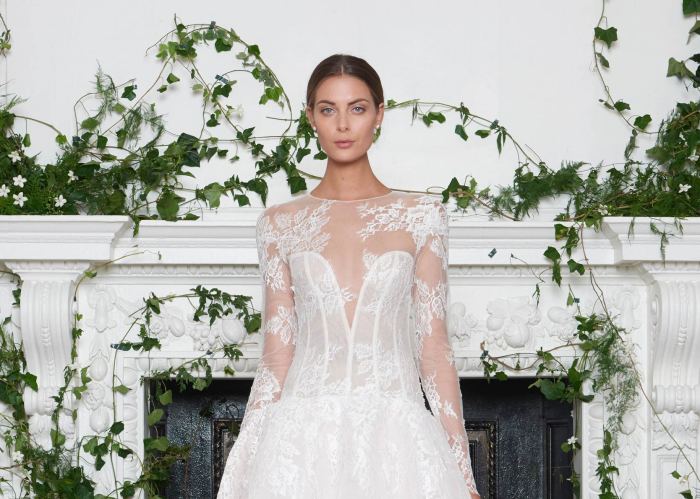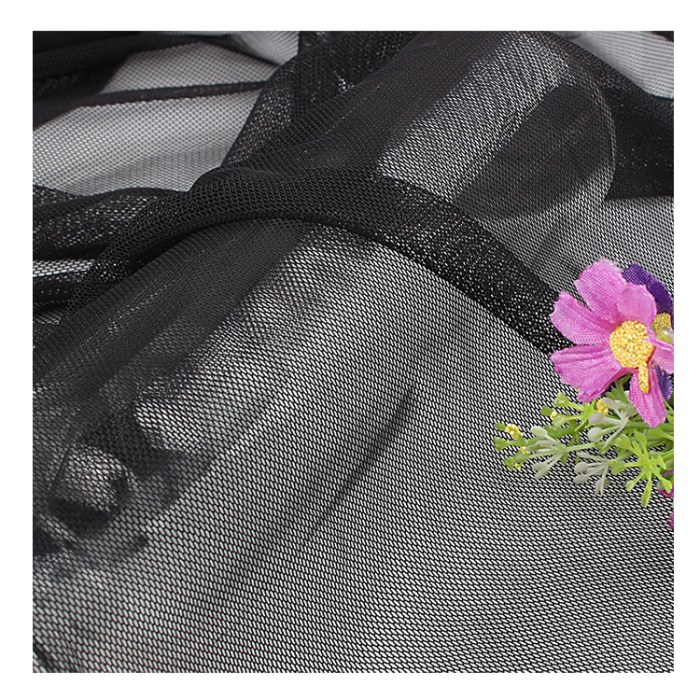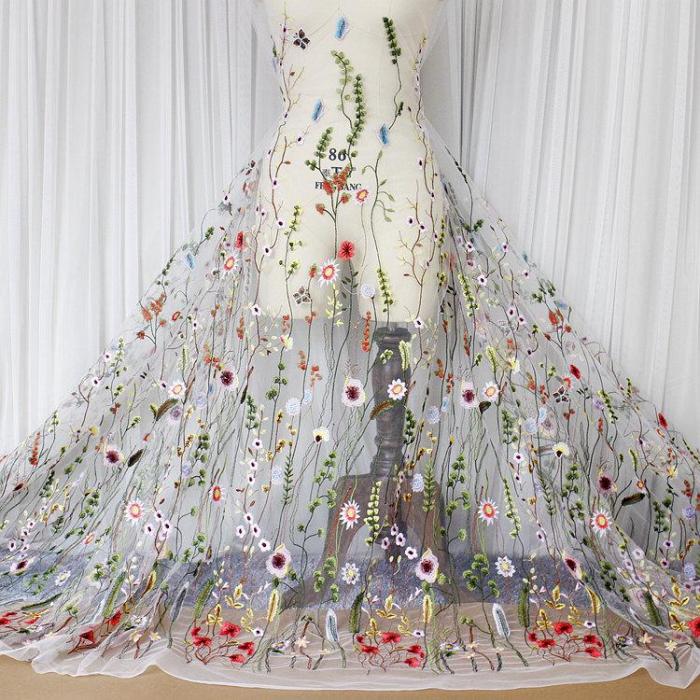Popular Wedding Dress Fabrics
Wedding dress fabric material – Choosing the right fabric for your wedding dress is crucial, impacting both the aesthetic and the overall experience. The fabric dictates the drape, feel, and formality of the gown, aligning with your personal style and the wedding’s theme. This section explores some of the most popular fabrics, comparing their characteristics and suitability for various wedding styles.
Fabric Characteristics, Drape, Formality, and Weight

Source: makehappymemories.com
Several fabrics stand out as favorites for wedding gowns, each offering unique qualities. Understanding their properties helps in selecting the perfect fabric for your dream dress.
| Fabric | Weight | Texture | Formality |
|---|---|---|---|
| Satin | Medium to Heavy | Smooth, lustrous | Formal to Semi-Formal |
| Silk | Medium to Heavy | Smooth, luxurious, slightly sheer (depending on weave) | Formal |
| Lace | Light to Medium | Delicate, intricate, often sheer | Formal to Semi-Formal |
| Tulle | Light | Net-like, sheer | Formal to Semi-Formal |
| Chiffon | Light | Sheer, lightweight, flowing | Semi-Formal to Casual |
| Organza | Light to Medium | Stiff, crisp, sheer | Formal to Semi-Formal |
Satin and silk, for instance, offer a luxurious, heavier drape, ideal for more formal affairs. In contrast, chiffon and tulle provide a lighter, more flowing silhouette, suitable for less formal or bohemian styles. Lace adds a touch of delicate elegance to any dress, while organza’s crispness creates a structured, sophisticated look.
Fabric Properties and Suitability
Beyond aesthetics, fabric properties like weight, breathability, and durability significantly impact the overall wearability and longevity of a wedding dress. Considering these factors ensures both comfort and practicality on your special day.
Impact of Fabric Weight and Breathability
Heavier fabrics like satin and silk create a more structured and formal look, but they can be less breathable in warmer climates. Lighter fabrics such as chiffon and tulle are more comfortable in warmer weather due to their breathability. The weight also affects how the dress falls and moves, influencing the overall silhouette.
Durability and Care Requirements
Silk and satin, while luxurious, require delicate care, often needing dry cleaning. Lace can be more delicate and prone to snags. Tulle, chiffon, and organza are generally more durable and easier to care for.
Fabric Suitability for Body Types and Silhouettes
Flowing fabrics like chiffon and tulle are flattering on various body types, particularly for A-line and ballgown silhouettes. Heavier fabrics like satin can be structured to enhance specific body types, creating a defined shape for mermaid or sheath styles. Lace can add texture and visual interest to any silhouette.
Fabric Combinations and Design Elements: Wedding Dress Fabric Material
Combining different fabrics allows for creative design elements and enhances the overall visual appeal of a wedding dress. This section explores successful fabric combinations and provides examples of their application in wedding dress design.
Examples of Successful Fabric Combinations, Wedding dress fabric material
A popular combination is a satin bodice paired with a chiffon skirt, blending structure and flow. Lace appliqués on tulle create a romantic and delicate look. Silk can be combined with organza for a luxurious yet structured gown.
Fabric Combinations in Design Elements
Lace is often used for appliqués, detailing, or even as the primary fabric. Tulle is frequently used for skirts and overlays, creating volume and movement. Satin is commonly used for bodices and structured elements, providing a sleek, polished look.
Designed Wedding Dress with Multiple Fabrics
Imagine a wedding dress with a structured satin bodice, accentuating the waistline. The skirt would be a flowing chiffon, creating a romantic and elegant A-line silhouette. Delicate lace appliqués on the bodice and skirt would add a touch of intricate detail. The satin provides structure and sophistication, the chiffon adds movement and grace, and the lace introduces a touch of delicate femininity.
Pros and Cons of Combining Fabrics
- Pros: Enhanced visual interest, combination of textures and drapes, ability to create unique silhouettes, improved comfort and breathability.
- Cons: Increased cost, potential for clashing textures or colors, more complex construction and tailoring, increased care requirements.
Fabric and Season

Source: brisen.biz
Choosing the right wedding dress fabric is crucial; the feel and drape significantly impact the overall look. Consider factors like the season and desired aesthetic – a lightweight chiffon might be perfect for a summer wedding, while a heavier satin lends itself to more formal occasions. For inspiration on achieving a cohesive style, explore beautiful home décor ideas, such as those available at dekoartikel für dekorieren wohnzimmer , to see how textures and colors complement each other.
This can help inform your fabric selection for a truly stunning and harmonious wedding ensemble.
The season of your wedding significantly impacts fabric choice. Selecting the appropriate fabric ensures both comfort and style, making your special day enjoyable regardless of the weather.
Fabric Suitability for Different Seasons
Lighter fabrics like chiffon and tulle are ideal for spring and summer weddings, offering breathability and comfort in warmer temperatures. Heavier fabrics like satin and silk are more suitable for autumn and winter weddings, providing warmth and elegance.
Fabric Choice and Weather Conditions
In hot climates, lightweight and breathable fabrics are crucial for comfort. In colder climates, heavier fabrics provide warmth and protection. The choice should consider the specific weather conditions expected on the wedding day.
Tailoring Fabric Weight and Texture to the Season
For a summer wedding, a lightweight chiffon gown with delicate lace details would be ideal, offering both beauty and breathability. For a winter wedding, a heavier satin or silk gown with long sleeves would provide warmth and elegance.
Summer Wedding Dress Description
Imagine a flowing, A-line gown crafted from a lightweight silk chiffon. The sheer fabric drapes beautifully, allowing for gentle movement and a sense of airy grace. The pale pastel color complements the summer setting, while the delicate embroidery adds a touch of understated elegance. The dress’s breathability ensures comfort even on the warmest of days, making it the perfect choice for a summer celebration.
Fabric Cost and Sustainability
The cost and sustainability of wedding dress fabrics are important considerations. This section explores the price differences between fabrics and highlights eco-friendly options.
Cost Comparison of Wedding Dress Fabrics
Silk and lace tend to be among the most expensive options, while tulle and chiffon are generally more affordable. Satin falls somewhere in between. The cost varies depending on the quality and source of the fabric.
Eco-Friendly and Sustainable Fabric Options

Source: weddbook.com
Organic cotton, hemp, and recycled fabrics are increasingly popular choices for sustainable wedding dresses. These options minimize environmental impact and support ethical production practices.
Ethical Considerations in Fabric Sourcing
Choosing ethically sourced fabrics ensures fair labor practices and environmentally responsible production. Look for certifications such as GOTS (Global Organic Textile Standard) or OEKO-TEX to verify the sustainability and ethical production of the fabrics.
Cost and Sustainability Comparison Table
| Fabric | Cost (Relative) | Sustainability (Relative) | Ethical Considerations |
|---|---|---|---|
| Silk | High | Medium (depending on sourcing) | Consider sourcing from reputable, ethical suppliers. |
| Lace | Medium to High | Medium (depending on materials and production) | Check for certifications like OEKO-TEX. |
| Satin | Medium | Medium (depending on material composition) | Consider recycled polyester or organic cotton satin. |
| Tulle | Low to Medium | Low (often synthetic) | Look for tulle made from recycled materials. |
| Chiffon | Low to Medium | Low (often synthetic) | Consider organic silk chiffon or other sustainable alternatives. |
| Organza | Medium | Low (often synthetic) | Seek out organic or recycled organza options. |
FAQ Section
What is the most popular wedding dress fabric?
While preferences vary, satin and lace remain consistently popular choices for their elegant appeal and versatility.
How do I choose a fabric for a summer wedding?
Opt for lightweight and breathable fabrics like chiffon, tulle, or cotton blends to stay comfortable in warmer weather.
Can I mix different fabrics in my wedding dress?
Absolutely! Combining fabrics is a common design technique that can add texture and visual interest. Consult with a designer for expert guidance.
How do I care for my wedding dress after the wedding?
Professional cleaning and preservation are recommended to maintain the dress’s condition. Always follow the care instructions provided by the manufacturer.
What are some budget-friendly wedding dress fabric options?
Tulle, chiffon, and certain types of satin offer elegant looks at more accessible price points compared to silk or high-end lace.




